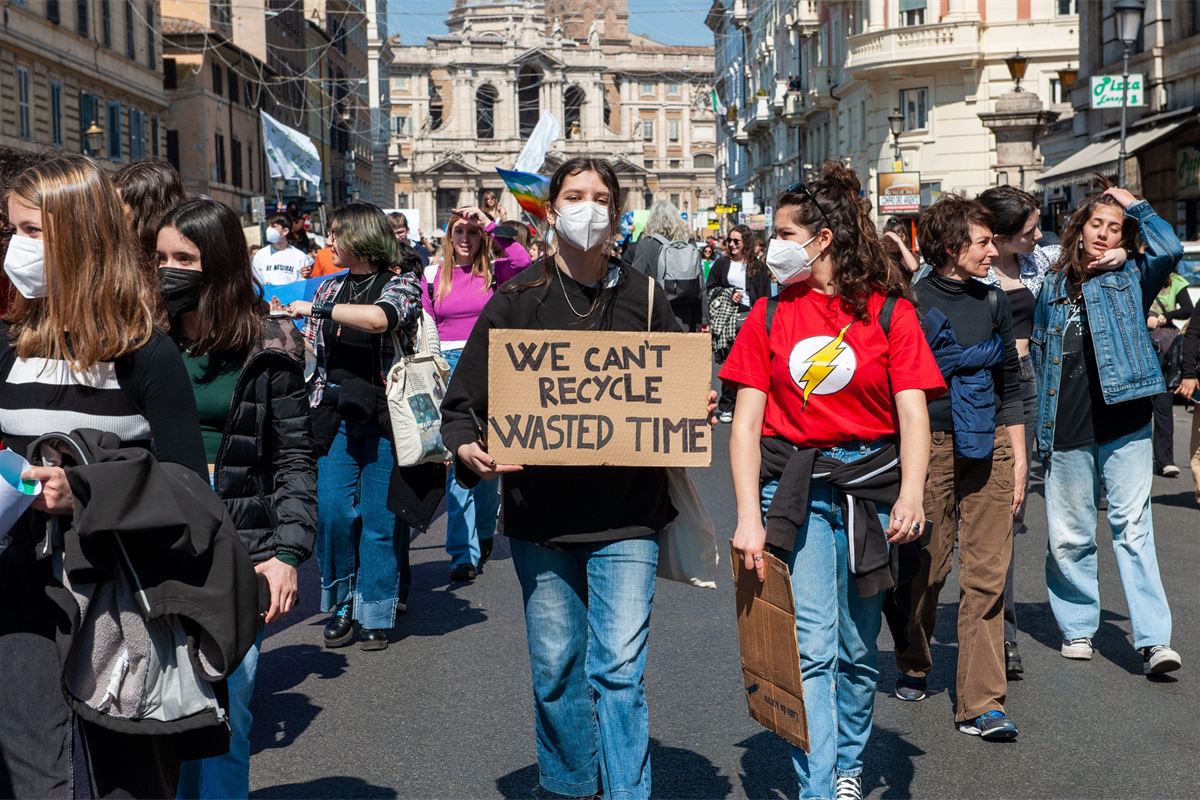Op-ed: Europe must be a climate policy leader for the sake of its society – The Parliament Magazine

Report on European Climate Action and Alignment with Sustainable Development Goals
Introduction: Climate Change Impacts and the Imperative for SDG 13
Europe is identified as the world’s most rapidly warming continent. This trend presents significant climate-related risks that directly challenge the achievement of multiple Sustainable Development Goals (SDGs). The primary threats include:
- SDG 7 (Affordable and Clean Energy) & SDG 2 (Zero Hunger): Risks to energy and food security.
- SDG 15 (Life on Land) & SDG 6 (Clean Water and Sanitation): Threats to ecosystems and water resources.
- SDG 11 (Sustainable Cities and Communities): Dangers to infrastructure.
- SDG 8 (Decent Work and Economic Growth): Impacts on financial stability.
- SDG 3 (Good Health and Well-being): Risks to public health.
Over the past four decades, extreme weather events have resulted in 85,000 to 145,000 fatalities and economic losses exceeding half a trillion euros, underscoring the urgent need for robust climate action as mandated by SDG 13 (Climate Action).
European Union Climate Commitments and Progress
The European Union has initiated significant policy measures to address climate change and align its objectives with global sustainability targets.
- The European Green Deal, launched in 2019, established a goal of achieving climate neutrality by 2050, in line with the Paris Agreement and directly supporting SDG 13.
- The EU has successfully reduced its domestic greenhouse gas (GHG) emissions by 29% since 2005.
- Current assessments indicate the EU is on course to achieve a net GHG emissions reduction of at least 55% by 2030, compared to 1990 levels.
Challenges to Achieving Sustainable Development Goals
The Blind Spot of Consumption-Based Emissions and SDG 12
A significant challenge to the EU’s climate policy is its lack of accounting for imported, or consumption-based, emissions. This oversight has direct implications for SDG 12 (Responsible Consumption and Production).
- The EU’s consumption patterns and supply chains in sectors like energy, agriculture, and textiles generate negative environmental spillovers in other countries.
- These imported emissions, estimated to be nearly half of the continent’s domestic emissions, are not included in the EU’s climate legal framework.
- This omission calls into question the comprehensive validity of the EU’s climate targets and its global contribution to SDG 13.
Policy Derailment and Shifting Priorities
Recent policy developments suggest a potential weakening of the EU’s climate ambitions, which could derail progress towards its sustainability commitments.
- Difficulties in establishing an emissions reduction target for 2040 and uncertainties in the agriculture and transport sectors indicate a slowing pace.
- The upcoming Multiannual Financial Framework (MFF) proposal appears to prioritize security, defence, and competitiveness, with less emphasis on climate, environment, and sustainability, potentially undermining funding for actions related to SDG 13, SDG 14 (Life Below Water), and SDG 15 (Life on Land).
- A political “green backlash” is emerging, which threatens to weaken previously agreed commitments in favour of short-term economic goals, contrary to the integrated nature of the SDGs.
Recommendations for a Sustainable and Resilient Future
To achieve a transition that is economically competitive, socially equitable, and environmentally sustainable, a clear and consistent political strategy is required.
- Foster Green Investment: The transition from a fossil fuel-dependent economy requires significant investment. This can be achieved through targeted public funding and a predictable regulatory environment that incentivizes private capital towards green technologies, aligning with SDG 9 (Industry, Innovation, and Infrastructure) and SDG 17 (Partnerships for the Goals).
- Maintain Policy Coherence: A stable, long-term policy framework is essential to achieve a net-zero economy by 2050. Rolling back recently adopted legislation creates uncertainty and hinders the necessary mitigation efforts.
- Integrate Economic, Social, and Environmental Goals: The EU must pursue a path that balances economic competitiveness (SDG 8), social fairness (SDG 10), and environmental sustainability. This holistic approach is fundamental to realizing the 2030 Agenda for Sustainable Development.
Analysis of Sustainable Development Goals in the Article
1. Which SDGs are addressed or connected to the issues highlighted in the article?
-
SDG 3: Good Health and Well-being
The article connects climate change to human health by stating that extreme weather events have led to “85,000 to 145,000 human fatalities” in Europe over the past 40 years.
-
SDG 7: Affordable and Clean Energy
The article discusses the threat to Europe’s “energy security” from climate risks and the need to transition from an economy “addicted to fossil fuel-stranded assets,” which implicitly points to the need for clean energy solutions.
-
SDG 8: Decent Work and Economic Growth
The economic impact of climate change is a key theme, with the article mentioning “more than half a trillion euros in economic losses” and threats to “financial stability.” It also discusses the need for an “economically competitive” society during the green transition.
-
SDG 11: Sustainable Cities and Communities
The article highlights that climate risks threaten “infrastructure” and mentions the devastating impact of disasters like “storms, heatwaves and flooding” on societies, which directly relates to the resilience of communities.
-
SDG 12: Responsible Consumption and Production
The article explicitly criticizes the EU’s “consumption patterns” and the issue of “imported (or consumption-based) emissions” in sectors like agriculture and textiles. It also calls for a transition from a “linear, inefficient economy.”
-
SDG 13: Climate Action
This is the central SDG of the article. The entire text revolves around Europe as the “world’s fastest warming continent,” the need for “urgent action,” the EU’s climate policies (Green Deal), and its goals for reducing greenhouse gas (GHG) emissions.
2. What specific targets under those SDGs can be identified based on the article’s content?
-
SDG 13: Climate Action
- Target 13.1: Strengthen resilience and adaptive capacity to climate-related hazards and natural disasters in all countries.
- The article supports this by highlighting the need for “urgent action to safeguard our societies” from intensifying “extreme weather events such as storms, heatwaves and flooding.”
- Target 13.2: Integrate climate change measures into national policies, strategies and planning.
- This is directly addressed through the mention of the EU’s “Green Deal,” the goal of “achieving climate neutrality by 2050,” and the assessment of “national energy and climate plans.”
- Target 13.1: Strengthen resilience and adaptive capacity to climate-related hazards and natural disasters in all countries.
-
SDG 11: Sustainable Cities and Communities
- Target 11.5: By 2030, significantly reduce the number of deaths and the number of people affected and substantially decrease the direct economic losses relative to global gross domestic product caused by disasters, including water-related disasters, with a focus on protecting the poor and people in vulnerable situations.
- The article provides specific data related to this target, citing “85,000 to 145,000 human fatalities” and “more than half a trillion euros in economic losses” from climate-related events.
- Target 11.5: By 2030, significantly reduce the number of deaths and the number of people affected and substantially decrease the direct economic losses relative to global gross domestic product caused by disasters, including water-related disasters, with a focus on protecting the poor and people in vulnerable situations.
-
SDG 12: Responsible Consumption and Production
- Target 12.2: By 2030, achieve the sustainable management and efficient use of natural resources.
- The article points to this target by criticizing Europe’s “linear, inefficient economy” and highlighting the problem of “imported (or consumption-based) emissions,” which are not accounted for in current climate frameworks.
- Target 12.2: By 2030, achieve the sustainable management and efficient use of natural resources.
-
SDG 7: Affordable and Clean Energy
- Target 7.2: By 2030, increase substantially the share of renewable energy in the global energy mix.
- This target is implied by the article’s call to move away from an economy “addicted to fossil fuel-stranded assets” and to prioritize and reward “green technologies.”
- Target 7.2: By 2030, increase substantially the share of renewable energy in the global energy mix.
3. Are there any indicators mentioned or implied in the article that can be used to measure progress towards the identified targets?
- Greenhouse Gas (GHG) Emissions Levels: The article provides several quantitative indicators for measuring climate action progress.
- The goal to “reduce GHG net emissions by at least 55% by 2030, compared to 1990 levels.”
- The achievement of “a 29% decline [in domestic GHG emissions] since 2005.”
- The long-term goal of “achieving climate neutrality by 2050.”
- Economic and Human Losses from Disasters: The article provides historical data that serves as a baseline indicator for the impact of climate change.
- “85,000 to 145,000 human fatalities” over the past 40 years.
- “more than half a trillion euros in economic losses” over the same period.
- Consumption-Based Emissions: The article introduces a specific, though often overlooked, indicator.
- “Imported emissions” are estimated to “represent nearly half of the continent’s domestic emissions,” highlighting a critical metric for assessing the true environmental footprint of consumption.
4. Table of SDGs, Targets, and Indicators
| SDGs | Targets | Indicators |
|---|---|---|
| SDG 13: Climate Action |
|
|
| SDG 11: Sustainable Cities and Communities |
|
|
| SDG 12: Responsible Consumption and Production |
|
|
| SDG 3: Good Health and Well-being |
|
|
Source: theparliamentmagazine.eu
What is Your Reaction?
 Like
0
Like
0
 Dislike
0
Dislike
0
 Love
0
Love
0
 Funny
0
Funny
0
 Angry
0
Angry
0
 Sad
0
Sad
0
 Wow
0
Wow
0
















































/environment-climate-change-and-health-(ech)/water-sanitation-hygiene-and-health-(wsh)/landfill-tuvalu-36092.tmb-1200v.jpg?sfvrsn=5c21fe40_1#)

.jpg.webp?itok=0ZsAnae9#)

























